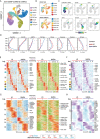This is a preprint.
Common and divergent gene regulatory networks control injury-induced and developmental neurogenesis in zebrafish retina
- PMID: 37790324
- PMCID: PMC10543505
- DOI: 10.21203/rs.3.rs-3294233/v1
Common and divergent gene regulatory networks control injury-induced and developmental neurogenesis in zebrafish retina
Update in
-
Common and divergent gene regulatory networks control injury-induced and developmental neurogenesis in zebrafish retina.Nat Commun. 2023 Dec 20;14(1):8477. doi: 10.1038/s41467-023-44142-w. Nat Commun. 2023. PMID: 38123561 Free PMC article.
Abstract
Following acute retinal damage, zebrafish possess the ability to regenerate all neuronal subtypes. This regeneration requires Müller glia (MG) to reprogram and divide asymmetrically to produce a multipotent Müller glia-derived neuronal progenitor cell (MGPC). This raises three key questions. First, does loss of different retinal cell subtypes induce unique MG regeneration responses? Second, do MG reprogram to a developmental retinal progenitor cell state? And finally, to what extent does regeneration recapitulate retinal development? We examined these questions by performing single-nuclear and single-cell RNA-Seq and ATAC-Seq in both developing and regenerating retinas. While MG reprogram to a state similar to late-stage retinal progenitors in developing retinas, there are transcriptional differences between reprogrammed MG/MGPCs and late progenitors, as well as reprogrammed MG in outer and inner retinal damage models. Validation of candidate genes confirmed that loss of different subtypes induces differences in transcription factor gene expression and regeneration outcomes. This work identifies major differences between gene regulatory networks activated following the selective loss of different subtypes of retina neurons, as well as between retinal regeneration and development.
Conflict of interest statement
STATEMENT OF INTERESTS: S.B. co-founded, and is a shareholder of, CDI Labs LLC..
Figures







References
-
- Vihtelic T. S. & Hyde D. R. Light-induced rod and cone cell death and regeneration in the adult albino zebrafish (Danio rerio) retina. J. Neurobiol. 44, 289–307 (2000). - PubMed
Publication types
LinkOut - more resources
Full Text Sources

